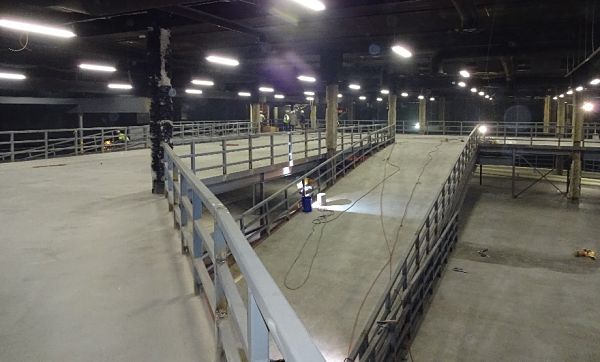ESI finished up 2016 with a number of notable projects. One project that got a lot of visibility (it was featured on the front page of the Star Tribune), was the design of the Smaaash go-kart track at the Mall of America. ESI teamed with Krech, O’Brien, Mueller & Associates (KOMA) in this fast-track effort to integrate the 1200-foot long, two-level track into the existing 4th floor structure.

Dr. Carl Nelson of ESI Engineering inspects the springs during installation.
Due to concerns that excessive vibration would be created by the go-karts, the team decided early on to elevate both levels of the track off of the existing composite steel floor and tie directly into the existing steel columns. This concept proved to be effective, but analysis showed that vibration caused by multiple karts at the top and bottom of the sloping ramps could still be an issue. The solution was to isolate both 90-foot ramps using heavy steel springs. This approach to vibration control has a long history, but requires special expertise and analysis to implement successfully.

The structure includes two 90-foot ramps connecting the two levels of the track.
Using a detailed finite element model of the entire track and the assumed dynamic loads of the go-karts, ESI determined the spring locations and properties that provided the required isolation. Concurrently, ESI worked with KOMA’s structural engineer, Matt Van Hoof to incorporate the springs into a structural design within the constraints imposed by the track’s construction and end use. Mason Industries, the spring supplier, provided valuable recommendations on the type of spring best suited for project. A total of 52 SLF-model springs provided the necessary stiffness and stability. In order to bridge the joint between the ramps and the fixed track structure, ESI designed a flexible strip fixed to each side of the gap, allowing the ramps to move while providing a smooth transition.

The ramps were constructed on temporary steel supports. Here the spring has been installed and the support is about to be removed.
Installation of the springs involved cooperation among general contractor Crawford Merz, Red Cedar Steel Erectors, Mason Industries’ local representative, and ESI. The installation was completed amidst a flurry of activity leading up the Smaaash grand opening on December 20, 2016. When the temporary steel supports were removed and two ramps were finally “floated” on the springs, it was still necessary to adjust each spring to achieve the proper height and distribution of loads. After a couple of late nights at the job site, the ramps were successfully floated and adjusted. The low natural frequency (less than 3 Hz) of the ramps could be readily felt by bouncing up and down on the balls on one’s feet. This attracted a lot of attention, as this structural behavior is outside of most people’s experience.

Joe of Red Cedar Erectors works on the spring installation.
The isolation worked perfectly. The ultimate test was the behavior of the ramps under real conditions with the entire fleet of go-karts on the track. With the naked eye, it could be seen that the ramps have just enough “give” to deflect a small but visible amount under the loads, thus providing effective isolation. The beauty of the design is that the acceleration associated with this motion is small enough to be imperceptible to the go-kart drivers.
As of the end of January, the track has been providing thrills for thousands of riders. ESI is ready for new challenging projects. While most projects do not make the front page of the newspaper, we like to think that every time we can help a client meet their goals, it’s a smash hit.


